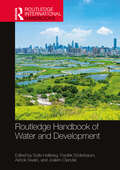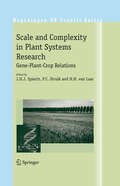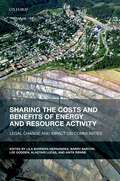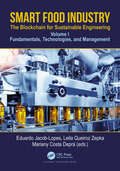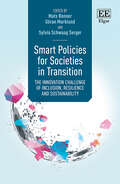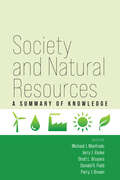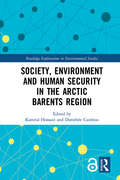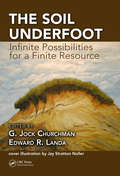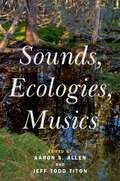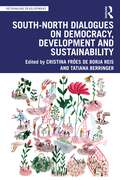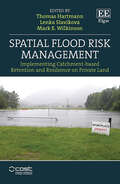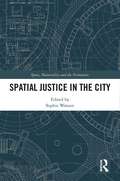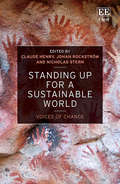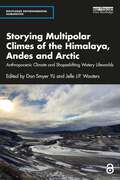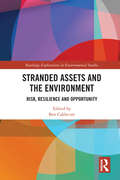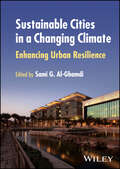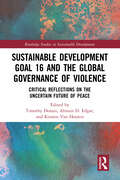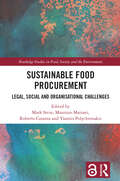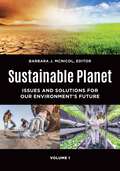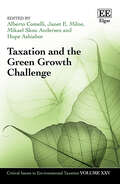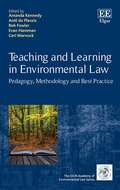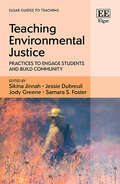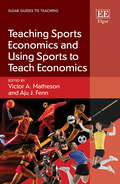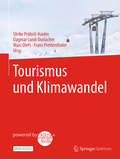- Table View
- List View
Routledge Handbook of Water and Development (Routledge International Handbooks)
Water is essential for human life and at the centre of political, economic, and socio-cultural development. This Routledge Handbook of Water and Development offers a systematic, wide-ranging, and state-of-the-art guide to the diverse links between water and development across the globe. It is organized into four parts: Part I explores the most significant theories and approaches to the relationship between water and development. Part II consists of carefully selected in-depth case studies, revealing how water utilization and management are deeply intertwined with historical development paths and economic and socio-cultural structures. Part III analyses the role of governance in the management of water and development. Part IV covers the most urgent themes and issues pertaining to water and development in the contemporary world, ranging from climate change and water stress to agriculture and migration. The 32 chapters by leading experts are meant to stimulate researchers and students in a wide range of disciplines in the social and natural sciences, including Geography, Environmental Studies, Development Studies, and Political Science. The Handbook will also be of great value to policymakers and practitioners.
Scale and Complexity in Plant Systems Research: Gene-Plant-Crop Relations (Wageningen UR Frontis Series #21)
The growing demand for food and increasing scarcity of fertile land and other resources (water, energy, etc. ) present multiple challenges to plant and crop scientists to meet the demands of future generations while protecting the environment and conserve biological diversity. Novel directions in linking basic plant sciences to crop and systems research are needed to meet the growing demand for food in a sustainable way. Crop performance can be changed by modifying genetic traits of the plant through plant breeding or changing the crop environment through agronomic management practices. To achieve that, systems analysis and modelling play an important role by integrating and evaluating new findings at the gene and plant level at higher scales of aggregation. Robust crop-physiological modelling can become an essential tool to use insights from functional genomics in explaining crop behaviour. Current crop models can predict crop performance over a range of environmental conditions. Recently QTL information has been incorporated into crop models, and this has proved the potential of narrowing genotype– phenotype gaps and of applying QTL-based models for the analysis of genotype-- environment interactions. To make further progress, model structure must be upgraded to allow for more physiological feedback features. Model input parameters should be designed to be potentially grounded in gene-level understanding. Integration of crop modelling into genetic and genomic researches can enhance the future position of crop physiology in ‘plant breeding by design’ (Yin, X.
Sharing the Costs and Benefits of Energy and Resource Activity: Legal Change and Impact on Communities
A new phase is emerging in the relationship between energy and resource activities and the communities that are affected by them. Any energy or resource project - a mine, a wind farm, a dam for hydroelectricity, or a shale gas development - will involve a mix of impacts and benefits for communities. For many years, the law has mediated impacts on communities and provided for the distribution of financial benefits. Now, there is growing awareness of the need to consider not only a wider range of costs and benefits for communities from energy and resource projects, but also the effects on communities at multiple scales and in complex ways. Sharing the costs and benefits of natural resource activity has now become a legal requirement for energy and resource projects operating in many jurisdictions, particularly in developing countries. This book uses cases studies from across the globe to examine the emergence of such legal measures, their advantages and disadvantages, and the improvements that may be feasible in the legal frameworks used to distribute the costs and benefits of energy and resources activity. The book has three parts: Part I considers general legal and conceptual frameworks; Part II addresses the mechanisms available to distribute costs and benefits; and Part III considers the role of public engagement and participation in the sharing of the costs and benefits from energy and resource projects.
Smart Food Industry: Fundamentals, Technologies, and Management, Volume 1
Smart Food Industry: The Blockchain for Sustainable Engineering, Volume I - Fundamentals, Technologies, and Management is a comprehensive overview of the current state of knowledge about food engineering and processing, under sustainable engineering perspective. This book includes disruptive approaches that will potentially enable the food industry for the transition to sustainable production. Divided into four parts, the book explores (i) fundamentals of sustainable food, (ii) conventional technologies in the food industry, (iii) sustainabile emerging technologies in food industries, and (iv) sustainable management in food industries. The book is an invaluable reference resource for students, researchers, graduates, and professionals, in general, who wish to gain knowledge in the engineering and food processing area as well as about sustainable food industry practices.
Smart Policies for Societies in Transition: The Innovation Challenge of Inclusion, Resilience and Sustainability
This is an open access title available under the terms of a CC BY-NC-ND 4.0 License. It is free to read, download and share on Elgaronline thanks to generous funding support from The Swedish Governmental Agency For Innovation Systems, Vinnova.This timely book expertly examines ongoing pressing issues in the modern world namely, an unstable economic climate, political turmoil and the environmental crisis. It takes a unique look at how science, technology and innovation could contribute towards the creation of a smarter and more resilient society by allowing more inclusive approaches into how science is integrated.With an insightful global interdisciplinary approach, Smart Policies for Societies in Transition combines in-depth theoretical analysis whilst also providing a reflective look at broadening the scope of science and innovation policy in order to understand the critical issues and challenges. Chapters illustrate historical practices and events, and discuss how the move to smart politics and the linking of boundaries from a social, ecological and global viewpoint leads to fewer but more creative policies.With its retrospective and forward-thinking perspectives, this book will be an excellent resource for academics wanting to rethink their approach to science and innovation governance, whilst scholars will find the collaborative method for combining policy analysis with theory of policymaking and governance informative and illuminating.
Society and Natural Resources: A Summary of Knowledge (Society and Natural Resources Book Series)
This book is a reprint of the original edited volume first published in 2004. In thirty-one chapters, the edited volume documents the exciting period of the emerging interdisciplinary field of society and natural resource scholarship from 1986 to 2004. It was published in part to commemorate the tenth International Symposium on Society and Resources Management (ISSRM) in Keystone, Colorado. ISSRM has brought together natural resource professionals, social science researchers, non-government agencies, private sector organizations, and students on a biennial basis since 1986. The book presents the most significant contributions to the symposia hosted by Pennsylvania State University, Colorado State University, University of Wisconsin-Madison, Texas A&M University, University of Illinois at Urbana-Champaign, Oregon State University, University of Missouri at Columbia, Western Washington University, and Indiana University. The first International ISSRM was held in Belize, Australia, and Italy and started a fruitful cross-continental exchange on society and natural resources showcased in this book. Contributors: Jim Absher, Kathleen Andereck, Jill Belsky, John Bergstrom, Carter Betz, Alan Bright, Perry J. Brown, Tommy Brown, Mark Brunson, Rabel Burdge, Fred Buttel, KristinCheek, Chia-Kuen Cheng, Tony Cheng, David Cole, H Ken Cordell, Terry Daniel, Steven Daniels, Dan Decker, Robert Ditton, John Dwyer, Alan Ewert, Don Field, Myron Floyd, R Bruce Gill, Alan Graefe, Gary Green, Doug Jackson-Smith, Rebecca Johnson, Richard Knopf, Rick Krannich, Jessica Leahy, Xinran You Lehto, John Loomas, Al Luloff, Mike Manfredo, Robert Manning, Sarah McCaffrey, Stephen McCool, Yoon-Jung Oh, Joseph O'Leary, Carol Saunders, Steve Selin, Bruce Shindler, George Stankey, Bill Stewart, Vicky Sturtevant, Jonathan Taylor, Suzanne Taylor, Tara Teel, Brijesh Thapa, Gene Theodori, Carla Koons Trentelman, Jerry Vaske, Joanne Vining, Doug Whittaker, Dan Williams
Society, Environment and Human Security in the Arctic Barents Region (Routledge Explorations in Environmental Studies)
The Arctic-Barents Region is facing numerous pressures from a variety of sources, including the effect of environmental changes and extractive industrial developments. The threats arising out of these pressures result in human security challenges. This book analyses the formation, and promotion, of societal security within the context of the Arctic-Barents Region. It applies the human security framework, which has increasingly gained currency at the UN level since 1994 (UNDP), as a tool to provide answers to many questions that face the Barents population today. The study explores human security dimensions such as environmental security, economic security, health, food, water, energy, communities, political security and digital security in order to assess the current challenges that the Barents population experiences today or may encounter in the future. In doing so, the book develops a comprehensive analysis of vulnerabilities, challenges and needs in the Barents Region and provides recommendations for new strategies to tackle insecurity and improve the wellbeing of both indigenous and local communities. This book will be a valuable tool for academics, policy-makers and students interested in environmental and human security, sustainable development, environmental studies and the Arctic and Barents Region in particular.
Society, Environment and Human Security in the Arctic Barents Region (Routledge Explorations in Environmental Studies)
The Arctic-Barents Region is facing numerous pressures from a variety of sources, including the effect of environmental changes and extractive industrial developments. The threats arising out of these pressures result in human security challenges. This book analyses the formation, and promotion, of societal security within the context of the Arctic-Barents Region. It applies the human security framework, which has increasingly gained currency at the UN level since 1994 (UNDP), as a tool to provide answers to many questions that face the Barents population today. The study explores human security dimensions such as environmental security, economic security, health, food, water, energy, communities, political security and digital security in order to assess the current challenges that the Barents population experiences today or may encounter in the future. In doing so, the book develops a comprehensive analysis of vulnerabilities, challenges and needs in the Barents Region and provides recommendations for new strategies to tackle insecurity and improve the wellbeing of both indigenous and local communities. This book will be a valuable tool for academics, policy-makers and students interested in environmental and human security, sustainable development, environmental studies and the Arctic and Barents Region in particular.
The Soil Underfoot: Infinite Possibilities for a Finite Resource
The largest part of the world's food comes from its soils, either directly from plants, or via animals fed on pastures and crops. Thus, it is necessary to maintain, and if possible, improve the quality-and hence good health-of soils, while enabling them to support the growing world population. The Soil Underfoot: Infinite Possibilities for a Finite
Sounds, Ecologies, Musics
Sounds, Ecologies, Musics poses exciting challenges and provides fresh opportunities for scholars, scientists, environmental activists, musicians, and listeners to consider music and sound from ecological standpoints. Authors in Part I examine the natural and built environment and how music and sound are woven into it, how the environment enables music and sound, and how the natural and cultural production of music and sound in turn impact the environment. In Part II, contributors consider music and sound in relation to ecological knowledges that appear to conflict with, yet may be viewed as complementary to, Western science: traditional and Indigenous ecological and environmental knowledges. Part III features multidisciplinary and interdisciplinary approaches by scholars, scientists, and practitioners who probe the ecological imaginary regarding the complex ideas and contested keywords that characterize ecomusicology: sound, music, culture, society, environment, and nature. A common theme across the book is the idea of diverse ecologies. Once confined to the natural sciences, the word "ecology" is common today in the social sciences, humanities, and arts - yet its diverse uses have become imprecise and confusing. Engaging the conflicting and complementary meanings of "ecology" requires embracing a both/and approach. Diverse ecologies are illustrated in the methodological, terminological, and topical variety of the chapters as well as the contributors' choice of sources and their disciplinary backgrounds. In times of mounting human and planetary crises, Sounds, Ecologies, Musics challenges disciplinarity and broadens the interdisciplinary field of ecomusicologies. These theoretical and practical studies expand sonic, scholarly, and political activism from the diversity-equity-inclusion agenda of social justice to embrace the more diverse and inclusive agenda of ecocentric ecojustice.
South-North Dialogues on Democracy, Development and Sustainability (Rethinking Development)
This book shows how bringing together experts from the Global South and the Global North can help us to understand and combat global economic, political, and social inequalities. For too long, the world’s problems have been viewed through the narrow conceptual lenses of the Global North. This book lays the groundwork for a new approach – a truly global approach to political economy. We are currently facing multiple and overlapping international crises. The current economic crisis, characterized by deepening inequalities, is closely intertwined with intensifying geopolitical rivalries and the environmental crisis. The dialogues in this book aim to move beyond the Eurocentric tradition and bring voices from the Global South to the forefront of the debate. Covering 11 key themes drawn from the United Nations’ Agenda 2030, the book conceptualizes democracy, development, and sustainability not only as strategies, but also as values that are integrated into the same – and continuously changing – analytical process. This book will be of great interest to students, researchers, and experts in international relations, global development, and international political economy, and to anyone looking for new perspectives on pernicious problems.
Spatial Flood Risk Management: Implementing Catchment-based Retention and Resilience on Private Land
This is an open access title available under the terms of a CC BY-NC-ND 4.0 License. It is free to read, download and share at Elgaronline.Centralizing the role of land and landowners, Spatial Flood Risk Management brings together knowledge from socio-economy, public policy, hydrology, geomorphology, and engineering to establish an interdisciplinary knowledge base on spatial approaches to managing flood risks.Discussing key barriers and sharing evidence-based best practices to flood risk management, international contributors involved in the LAND4FLOOD EU COST Action initiative (CA16209) seek transferrable solutions to the implementation challenges of nature-based solutions. Introducing the concept of spatial flood risk management, the multi-national teams of authors consider the notion of land through three analytical lenses: as a biophysical system, a socio-economic resource, and a solution to flood-risk management. Advocating for a more comprehensive approach, the book explores options of where and how to store water within catchments, including decentralized water retention in the hinterland, flood storage along rivers, and planned flooding in resilient cities.Bringing together the existing knowledge on the relation between flood risk management and land with an international and interdisciplinary scope, this book will prove invaluable to academics, policy makers and public authorities involved in flood risk management, urban planners, and governing environmental bodies.
Spatial Justice in the City
In the context of increasing division and segregation in cities across the world, along with pressing concerns around austerity, environmental degradation, homelessness, violence, and refugees, this book pursues a multidisciplinary approach to spatial justice in the city. Spatial justice has been central to urban theorists in various ways. Intimately connected to social justice, it is a term implicated in relations of power which concern the spatial distribution of resources, rights and materials. Arguably there can be no notion of social justice that is not spatial. Philippopoulos-Mihalopoulos has argued that spatial justice is the struggle of various bodies – human, natural, non-organic, technological – to occupy a certain space at a certain time. As such, urban planning and policy interventions are always, to some extent at least, about spatial justice. And, as cities become ever more unequal, it is crucial that urbanists address questions of spatial justice in the city. To this end, this book considers these questions from a range of disciplinary perspectives. Crossing law, sociology, history, cultural studies, and geography, the book’s overarching concern with how to think spatial justice in the city brings a fresh perspective to issues that have concerned urbanists for several decades. The inclusion of empirical work in London brings the political, social, and cultural aspects of spatial justice to life. The book will be of interest to academics and students in the field of urban studies, sociology, geography, planning, space law, and cultural studies.
Standing up for a Sustainable World: Voices of Change
The world has witnessed extraordinary economic growth, poverty reduction and increased life expectancy and population since the end of WWII, but it has occurred at the expense of undermining life support systems on Earth and subjecting future generations to the real risk of destabilising the planet. This timely book exposes and explores this colossal environmental cost and the dangerous position the world is now in. Standing up for a Sustainable World is written by and about key individuals who have not only understood the threats to our planet, but also become witness to them and confronted them. Combining the voices of leading academics as well as climate change and environmental activists, entrepreneurs and investors, the book highlights the urgent action that needs to be taken to foster sustainable, resilient and inclusive development in the face of powerful systemic forces. Chapters look ahead to a better path for human wellbeing, security and dignity, offering insight to ways this can be created. The book as a whole shares the visions and hopes of those fighting in a myriad of ways to make a sustainable world, attempting to tip the balance away from the crushing loss of biodiversity, rising sea levels and increasing global mean temperature, whilst increasing living standards across all dimensions, particularly for the poorest people. An imperative read for those concerned about the future of our planet, this book showcases not only why urgent action is now imperative, but also what changes are necessary for a sustainable, resilient and equitable world. It offers crucial insights for those interested in the dynamics of political action, in how change occurs, and in effective communication. Environmental economics, as well as environmental studies and human geography students and scholars more broadly will find this an invigorating read.
Storying Multipolar Climes of the Himalaya, Andes and Arctic: Anthropocenic Climate and Shapeshifting Watery Lifeworlds (Routledge Environmental Humanities)
This book initiates multipolar climate/clime studies of the world’s altitudinal and latitudinal highlands with terrestrial, experiential, and affective approaches. Framed in the environmental humanities, it is an interdisciplinary, comparative study of the mutually-embodied relations of climate, nature, culture, and place in the Himalaya, Andes, and Arctic. Innovation-driven, the book offers multipolar clime case studies through the contributors’ historical findings, ethnographic documentations, and diverse conceptualizations and applications of clime, an overlooked but returning notion of place embodied with climate history, pattern, and changes. The multipolar clime case studies in the book are geared toward deeper, lively explorations and demonstrations of the translatability, interchangeability, and complementarity between the notions of clime and climate. "Multipolar" or "multipolarity" in this book connotes not only the two polar regions and the tectonically shaped highlands of the earth but also diversely debated perspectives of climate studies in the broadest sense. Contributors across the twelve chapters come from diverse fields of social and natural sciences and humanities, and geographically specialize, respectively, in the Himalayan, Andean, and Arctic regions. The first comparative study of climate change in altitudinal and latitudinal highlands, this will be an important read for students, academics, and researchers in environmental humanities, anthropology, climate science, indigenous studies, and ecology.
Stranded Assets and the Environment: Risk, Resilience and Opportunity (Routledge Explorations in Environmental Studies)
Drawing on the work of leading researchers and practitioners from a range of disciplines, including economic geography, economics, economic history, finance, law, and public policy, this edited collection provides a comprehensive assessment of stranded assets and the environment, covering the fundamental issues and debates, including climate change and societal responses to environmental change, as well as its origins and theoretical basis. The volume provides much needed clarity as the discourse on stranded assets gathers further momentum. In addition to drawing on scholarly contributions, there are chapters from practitioners and analysts to provide a range of critical perspectives. While chapters have been written as important standalone contributions, the book is intended to systematically take the reader through the key dimensions of stranded assets as a topic of research inquiry and practice. The work adopts a broad based social science perspective for setting out what stranded assets are, why they are relevant, and how they might inform the decision-making of firms, investors, policymakers, and regulators. The topic of stranded assets is inherently multi-disciplinary, cross-sectoral, and multi-jurisdictional and the volume reflects this diversity. This book will be of great relevance to scholars, practitioners and policymakers with an interest in include economics, business and development studies, climate policy and environmental studies in general.
Sustainable Cities in a Changing Climate: Enhancing Urban Resilience
Sustainable Cities in a Changing Climate Build and manage the sustainable cities of the future with this comprehensive guide Climate change is among the biggest challenges facing today’s cities, which are in turn a major factor in driving or mitigating climate change. It is no surprise then that urban planning authorities are under mounting pressure to create cityscapes suited to the 21st century. Sustainable Cities in a Changing Climate offers a systematic overview of the environmental and sustainability challenges facing urban planners and policymakers, and how to meet those challenges. Beginning with an analysis of how climate change impacts built environments, it proceeds to offer quantitative analysis and practical solutions for strengthening urban resilience. Sustainable Cities in a Changing Climate readers will also find: A future-oriented approach that accounts for both known and unknown threats Detailed discussion of threats including environmental changes, global pandemics, natural disasters, and more Case studies from around the globe, including biofuel generation in China and the 2022 World Cup in Qatar Sustainable Cities in a Changing Climate is indispensable for environmental engineers, urban planners and policymakers, and advanced students in environmental planning and architecture.
Sustainable Development Goal 16 and the Global Governance of Violence: Critical Reflections on the Uncertain Future of Peace (Routledge Studies in Sustainable Development)
This book brings together a diverse range of scholars and practitioners working at the nexus of peace and development to reflect, at the mid-way point of the Sustainable Development Goals implementation period, what impact Goal 16 has made, or may yet make, toward reducing violence in ‘all its forms.’ Adopted in 2015, the Sustainable Development Goals include 17 objectives designed to shape and direct the global development agenda through to 2030, with Goal 16 aiming to promote ‘peaceful and inclusive societies for sustainable development.’ Amidst an ongoing global pandemic, evidence of a fracturing liberal international order, and the persistence of seemingly intractable conflict in large parts of the world, this volume takes stock of current progress toward providing access to justice and ensuring inclusive and democratic institutions. Across 15 chapters, the book’s contributors explore the universal aspirations of Goal 16 and its specific implications for conflict-affected states, which continue to experience ‘development in reverse,’ and for historically marginalized groups such as women, youth, the disabled, and indigenous peoples. In doing so, it offers a comprehensive assessment of Goal 16’s broader contribution to the creation of a more just, peaceful world against the realities of societies emerging from the COVID-19 pandemic and grappling with a deepening climate crisis. This volume will appeal to scholars, researchers, policymakers, and postgraduate students in sustainable development, global governance, international relations, global development, international law, and political science.
Sustainable Food Procurement: Legal, Social and Organisational Challenges (Routledge Studies in Food, Society and the Environment)
The book examines sustainable food procurement policy and practice in the European Union and beyond, exploring the extent to which sustainability objectives have been achieved and evaluating the new developments taking place at both EU and national levels.While there is a growing recognition that public authorities can use public procurement as a policy tool to pursue multiple environmental, health and socio-economic objectives, contracting authorities still face many challenges. This volume investigates the scope for pursuing sustainable objectives in public procurement of food and catering services, examining different regulatory contexts and organisational models to answer the overall question of how to integrate sustainability concerns into the various phases of public food procurement processes. Contributions in the book examine the policy and legal procurement framework and practices for sustainable public catering in three EU Member States: Italy, France and Spain. There is a comparative survey of the Baltic Region, including Denmark, Estonia, Finland, Poland and Russia, and moving beyond the EU, there is examination of the UK and Brazil, as well as a cross country comparison of the UK with Denmark and Sweden. Drawing on the expertise of an interdisciplinary and intersectoral team of contributors allows the book to benefit from the insights of different disciplines, including business sciences, anthropology and law. Tapping into the global discussion on public food procurement as a means to achieve multiple social and environmental goals, this work will stimulate readers looking for new creative ways to create value through public food purchasing.This book will be of great interest to students, researchers, policymakers and public- and private-sector representatives interested in public procurement, food policy and law, sustainable food sourcing and supply chain management.
Sustainable Planet [2 volumes]: Issues and Solutions for Our Environment's Future [2 volumes]
Sustainable Planet is a two-volume resource that provides comprehensive coverage on the world's most pressing environmental issues, their impact in countries around the world, and how—or if—they are being addressed.Sustainable Planet: Issues and Solutions for Our Environment's Future examines contemporary challenges to sustainability, including population, climate change, decreasing biodiversity, land degradation, and water quality. Each chapter analyzes one of these challenges by first providing an introduction to the topic as well as key concepts to provide readers with a basic understanding of the issue. Essays deepen comprehension by investigating different aspects of the challenge.Case studies written by experts in the field follow. Each case study considers how a specific country is affected by the particular issue as well as the measures the country is taking to find solutions that will provide for a more sustainable future. The final chapter of the book explores sustainability at a global level by examining, through annotated primary documents, a number of multinational initiatives and alliances intended to create a more sustainable planet.
Taxation and the Green Growth Challenge (Critical Issues in Environmental Taxation series)
Taxation and the Green Growth Challenge addresses the pressing issue of how economic growth can be compatible with the fight against climate change, while protecting the environment as much as possible. The book shows how decision-makers must account for the legal value of the environment as being of benefit to future generations.With a broad approach, and a combination of legal and economic points of view, chapters discuss which tax instruments enable us to combine economic growth and environmental protection in a balanced way. This discerning book identifies the tax instruments that permit a comprehensive arrangement of underlying economic and political interests, with a view to pursuing the UN’s and EU’s ambitious environmental goals. The impressive selection of contributors also reflect on global initiatives and legislation as well as exploring new environmental strategies.This book will be of great interest to researchers and scholars who wish to analyse in-depth environmental and natural resource taxation issues, including energy taxation and carbon pricing, as well as the circular economy and green taxes in the context of wider tax reforms. It will also appeal to industry advisors, policymakers and government officials.
Teaching and Learning in Environmental Law: Pedagogy, Methodology and Best Practice (The IUCN Academy of Environmental Law series)
This unique book focuses specifically on teaching and learning in environmental law, exploring innovative techniques, tools and technologies employed across the globe to teach this ever more important subject. Chapters identify particular challenges that environmental law poses for pedagogy, offering a mix of theory and practical guidance to legal scholars who are seeking to take up, or improve, their teaching of this subject.Providing an examination of teaching formats and methodologies that are both innovative and particularly adapted to the teaching of environmental law, contributions explore topics such as digital learning, joint teaching, flipped classrooms and scenario-based approaches, as well as discussing teacher-based, reflective, student-centred and research-based methods. The book also considers specific contexts for teaching environmental law such as specialized postgraduate programs, supervision methods for research students, teaching within non-law programs, and teaching online. Environmental law scholars at all levels of university instruction will find this book an invaluable opportunity to learn about new methods and approaches to teaching in this area. Its insights into legal teaching methodologies more broadly will also be of interest to legal academics in other areas of the law.
Teaching Environmental Justice: Practices to Engage Students and Build Community (Elgar Guides to Teaching)
This ground-breaking book presents interdisciplinary educators with classroom tools and strategies to integrate environmental justice into their courses. Providing accessible, flexible, and evidence-based pedagogical approaches designed by a multidisciplinary team of scholars, it centers equity and justice in student learning and course design. It further presents a model for community-based faculty development that can communicate those pedagogical approaches across disciplines.Key Features:Reflection on how to teach inclusively across disciplines, with a focus on community-based faculty development.Presentation of a blend of insights from diverse disciplines, including art, astronomy, ecology, economics, history, political science, and online education.A focus on how to stimulate student engagement to improve students’ empirical and conceptual understanding of environmental politics.Detailed instructions for both introductory and more advanced active learning assignments and classroom activities, including guidance on how to manage common challenges and adapt activities to specific learning environments, particularly online formatsProviding detailed instructions and reflections on teaching effectively and inclusively, Teaching Environmental Justice will be an invaluable resource for faculty and graduate students teaching modules in environmental justice in courses across disciplines. It will also be essential reading for researchers of teaching and learning seeking insight into cutting-edge classroom practices that center equity and justice in student learning.
Teaching Sports Economics and Using Sports to Teach Economics (Elgar Guides to Teaching)
There is a dire need for a comprehensive pedagogical resource both on diverse approaches to teaching sports economics and the use of sports to teach broader principles of economic concepts. This book does exactly that. The contributions from leading scholars and teachers in both fields will help all instructors looking to raise their teaching game.The pedagogy in this book covers a wide array of active and engaged teaching techniques to demonstrate interesting ways to engage students and to get them excited about sports economics and economic concepts in general. Chapters cover topics such as legal case studies that impact North American leagues, discrimination and gender bias in sports economics and best practices for supervising undergraduate student research. The innovative approaches and methods presented are applicable to both small and large class sizes. Practical advice for designing field trip-, guest speaker-, and case-study-based classes, and techniques for using data-driven exercises, film and straightforward classroom experiments are included.This book will appeal to two primary audiences: undergraduate economics instructors and sports economics/management instructors. The teaching methods may be easily adapted to most economic classes, and the breadth of material provides instructors with assistance in creating course syllabi, outlining teaching plans, generating student interest, and increasing the efficacy of their pedagogy.
Tourismus und Klimawandel
Diese Open-Access-Publikation beleuchtet die komplexen Beziehungen zwischen Tourismus und Klimawandel für die Tourismusdestination Österreich und basiert auf einer umfassenden Erhebung, Zusammenfassung und Bewertung des aktuellen Standes der Forschung zu diesem Thema. Für diesen Bericht haben 40 Wissenschaftler*innen führender Forschungseinrichtungen, unterstützt durch ein internationales Team an Begutachter*innen, mehr als zwei Jahre intensiv zusammengearbeitet.Die dargestellten Forschungsarbeiten zum Einfluss des Klimawandels auf den Tourismus gehen davon aus, dass sich die in den nächsten Jahrzehnten zu erwartenden Veränderungen des Klimas sehr stark auf die österreichische Tourismusbranche auswirken werden. Allerdings fällt dem Sektor auch eine nicht unerhebliche Rolle als Mitverursacher des Klimawandels zu. Aktuellen Untersuchungen zufolge verursacht der Tourismus rund 8% aller globalen CO2-Emissionen. Vor diesem Hintergrund werden für die verschiedenen Teilaspekte des touristischen Angebots geeignete Minderungs- und Anpassungsmaßnahmen vorgestellt und diskutiert.Der Bericht verdeutlicht insbesondere die spezifische Betroffenheit der touristischen Outdoor-Aktivitäten vom Wintersport bis zum Golftourismus, beschreibt die neuen Herausforderungen für den Städtetourismus und die Organisation von Events und beleuchtet ausführlich, wie Anpassungsmöglichkeiten, insbesondere im Bereich der Mobilität, der Beherbergung, touristischer Indoor-Angebote, sowie der Gastronomie und Kulinarik, ausgestaltet und umgesetzt werden können. Dabei werden die Verantwortung und die Möglichkeiten des Reisenden ebenso dargestellt, wie die Handlungsoptionen von Betrieben, Destinationen und der rahmensetzenden nationalen Politik. Das Buch macht deutlich, dass, um die Pariser Klimaziele erreichen zu können, ein veränderter Lebensstil und rasche Umsetzungsschritte notwendig sind. Wie dieser „Paris-Lifestyle“ erreicht werden könnte und welche Herausforderungen auf diesem Weg bewältigt werden müssen, verdeutlichen die zusammenfassenden Schlusskapitel.Die vorliegende differenzierte Aufbereitung des Themas für alle Reisenden, die Tourismusbranche und die Politik war nur durch eine gezielte Förderung aus Mitteln des Klima- und Energiefonds im Rahmen des Programms „Austrian Climate Research Programme – ACRP“ möglich.
